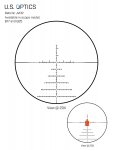Those of you that compete in PRS and utilize holdovers with an Christmas tree reticle, which of the different reticles do you feel is best (EBR-7C, H59, Tremor 3, Gen 3 XR, MIL-XT, MR4, SKMR3, GR2ID etc)?
What ranges do you utilize holdover and when do you dial? Or is it a factor of target size and time limit? Do any of the reticles have a red flag as far as dots being too large and obscures impacts or makes it harder to see trace. Or are any of them less usable at PRS magnification ranges?
I understand that field of view is also important as well as depth of field, are these secondary to the reticle?
What ranges do you utilize holdover and when do you dial? Or is it a factor of target size and time limit? Do any of the reticles have a red flag as far as dots being too large and obscures impacts or makes it harder to see trace. Or are any of them less usable at PRS magnification ranges?
I understand that field of view is also important as well as depth of field, are these secondary to the reticle?


